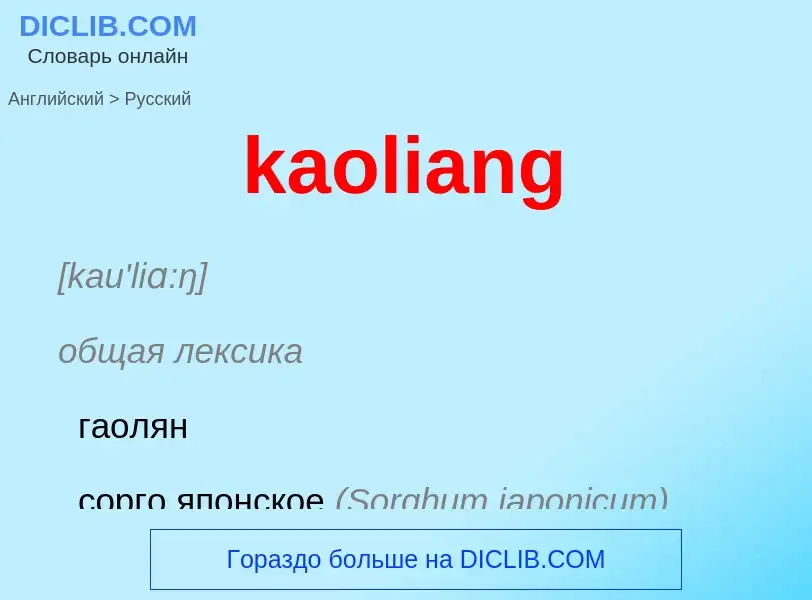Перевод и анализ слов искусственным интеллектом ChatGPT
На этой странице Вы можете получить подробный анализ слова или словосочетания, произведенный с помощью лучшей на сегодняшний день технологии искусственного интеллекта:
- как употребляется слово
- частота употребления
- используется оно чаще в устной или письменной речи
- варианты перевода слова
- примеры употребления (несколько фраз с переводом)
- этимология
kaoliang - перевод на русский
[kau'liɑ:ŋ]
общая лексика
гаолян
сорго японское (Sorghum japonicum)
существительное
ботаника
гаолян
сорго восточно-азиатское (Sorghum japonicum)
Википедия

Commercial sorghum is the cultivation and commercial exploitation of species of grasses within the genus Sorghum (often S. bicolor, sometimes Sorghum arundinaceum). These plants are used for grain, fibre and fodder. The plants are cultivated in warmer climates worldwide. Commercial Sorghum species are native to tropical and subtropical regions of Africa and Asia.
Other names include durra, Egyptian millet, feterita, Guinea corn, jwari ज्वारी (Marathi), jowar, juwar, milo, shallu, Sudan grass, cholam (Tamil), jola/ಜೋಳ (Kannada), jonnalu జొన్నలు (Telugu), gaoliang (zh:高粱), great millet, kafir corn, dura, dari, mtama, and solam.
Sorghum has been, for centuries, one of the most important staple foods for millions of poor rural people in the semiarid tropics of Asia and Africa. For some impoverished regions of the world, sorghum remains a principal source of energy, protein, vitamins and minerals. Sorghum grows in harsh environments where other crops do not grow well, just like other staple foods, such as cassava, that are common in impoverished regions of the world. It is usually grown without application of any fertilizers or other inputs by a multitude of small-holder farmers in many countries.
Grain sorghum is the third most important cereal crop grown in the United States and the fifth most important cereal crop grown in the world. In 2010, Nigeria was the world's largest producer of grain sorghum, followed by the United States and India. In developed countries, and increasingly in developing countries such as India, the predominant use of sorghum is as fodder for poultry and cattle. Leading exporters in 2010 were the United States, Australia and Argentina; Mexico was the largest importer of sorghum.
An international effort is under way to improve sorghum farming. The International Crops Research Institute for the Semi-Arid Tropics (ICRISAT) has improved sorghum using traditional genetic improvement and integrated genetic and natural resources management practices. New varieties of sorghum from ICRISAT has now resulted in India producing 7 metric tons per hectare (2.8 long ton/acre; 3.1 short ton/acre). Some 194 improved cultivars are now planted worldwide. In India, increases in sorghum productivity resulting from improved cultivars have freed up 7 million hectares (17 million acres) of land, enabling farmers to diversify into high-income cash crops and boost their livelihoods. Sorghum is used primarily as poultry feed, and secondarily as cattle feed and in brewing applications.


![Somali]] flour (''massaggo'') Somali]] flour (''massaggo'')](https://commons.wikimedia.org/wiki/Special:FilePath/Massaggocad1.jpg?width=200)

![S. bicolor]]'' S. bicolor]]''](https://commons.wikimedia.org/wiki/Special:FilePath/Sorghum bicolor03.jpg?width=200)
